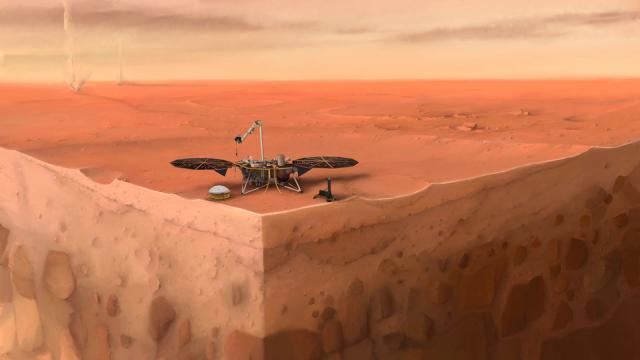Scientists have published a treasure trove of new research from the InSight lander’s first year on Mars, showing just how active the Red Planet really is.
InSight touched down on Mars’ Elysium Planitia in November 2018. It has an impressive suite of instruments, including cameras, weather sensors, magnetic field sensors, a heat probe, and a seismometer designed to measure “marsquakes.” Today, scientists have published a host of results revealing that even without plate tectonics, the planet is constantly shuddering with quakes like those on Earth or the Moon. The new data also hints at strangeness surrounding the planet’s atmosphere and magnetic field.
The bulk of these new results come from InSight’s Seismic Experiment for Interior Structure, or SEIS experiment, which the lander finished deploying last February. From then until September 30, 2019, SEIS didn’t just measure the occasional quake; it counted 174 quakes, including 150 high-frequency and low-magnitude events that propagated through the Martian crust as well as 24 deeper, higher-magnitude events. The high-frequency events looked similar to those that the Apollo mission measured on the Moon, while low-frequency events came with compression and secondary events, called P and S waves, just like quakes you might see on Earth, according to a paper published in Nature Geoscience.
“We can start to use techniques we developed on Earth to learn abut Mars’s internal structure,” Vedran Lekic, associate professor at the University of Maryland who worked on some of the new papers, told Gizmodo. “That excited me, scientifically speaking.”
Now that researches know they can use Earth-inspired methods to study the quakes, they might be able to answer more questions about the size of the planet’s core and its composition. But actually studying the core will require some stronger events, and the scientists have yet to measure a quake with a magnitude greater than 4.
Lekic explained that Mars doesn’t have plate tectonics or tidal forces from a nearby planet to act on its surface like the Earth and Moon have, respectively, so it’s hard to pinpoint exactly what causes the events. However, the researchers determined that two of the largest quakes originated from the Cerberus Fossae system of fractures, which could behave like faults do on Earth. As the planet cools, it contracts, introducing stresses that can produce faults and, in turn, quakes.
The researchers were also able to use the SEIS instrument in combination with the hammering action of the mission’s troubled Heat Flow and Physical Properties Instrument to study the planet’s crust, according to another paper published in Nature Geoscience. The planet was seismically quiet at night, but activity increased during the day as heat moved around the atmosphere. This analysis also indirectly suggests that the topmost portion of the planet’s crust likely has lots of fractures and is relatively low in its volatile elements (those with low boiling points like nitrogen, ammonia, and carbon dioxide).
Another experiment, the sensor package intended simply to study the sources of extraneous noise in the SEIS measurements, has also provided a trove of insights for the researchers, according to a third Nature Geoscience paper. The magnetometer revealed that the crust’s magnetic field seems to be 10 times stronger than what spacecraft measured from Martian orbit—perhaps there are magnetized rocks near InSight’s landing site, recording a history where the planet once had a dynamo-driven magnetic field like the Earth has today. These magnetic fields also vary throughout the day as charged particles move through the Martian atmosphere, and researchers hope to use these varying magnetic fields to study the electrical properties beneath the surface.
InSight also observed a more active atmosphere than expected, measuring a local dust storm and using its cameras to measure wind speeds. The experiment revealed turbulence in the thin atmosphere similar to the turbulence on Earth, as well as a faint glow to the air, perhaps from reactions between particles in the atmosphere and sunlight. The experiment has also detected dust devils, though has yet to actually photograph one. (The Opportunity rover, however, did snap a great pic of nearby dust devil.)
The researchers hope to continue monitoring the planet’s various processes through the year and observe how they change. A radio experiment on InSight, the Rotation and Interior Structure Experiment (RISE), will offer more data on the nature of the Martian interior, such as whether the planet has a solid or liquid core. And scientists are still trying to figure out how to insert the Heat Probe into the planet; most recently, they decided to try to push on the top of the probe. It’s certainly frustrating that the Heat Probe experiment hasn’t been successful so far, but at least InSight has plenty of other instruments with which to gather data.
One thing is certain: Mars will continue to surprise scientists with each new mission.
